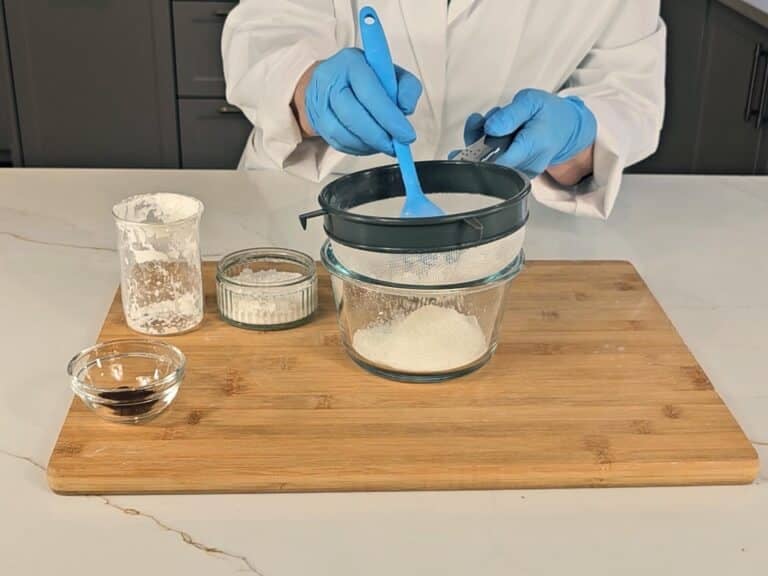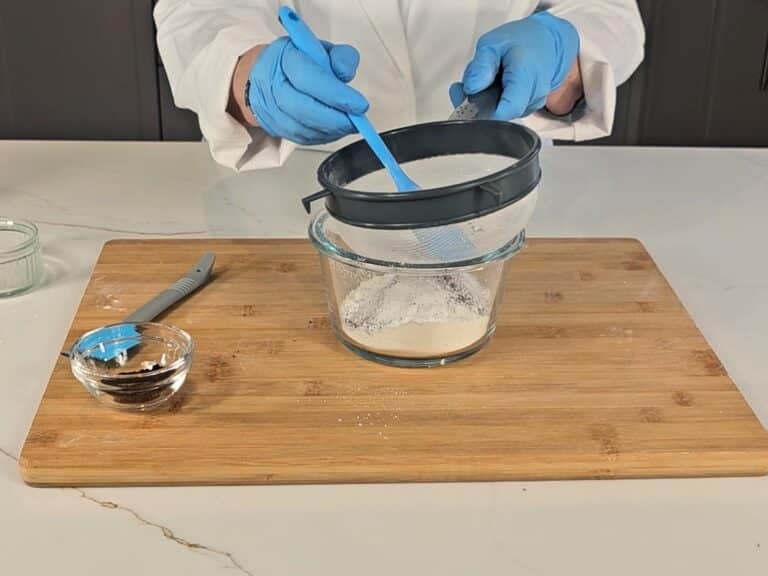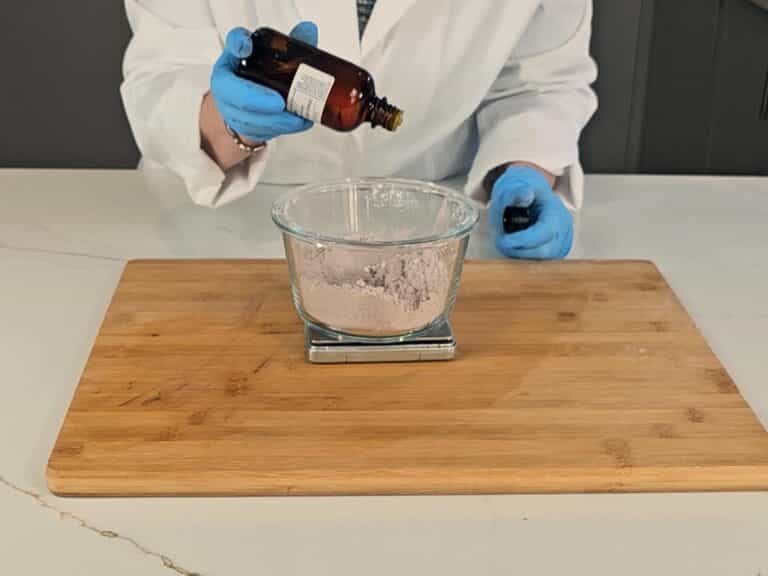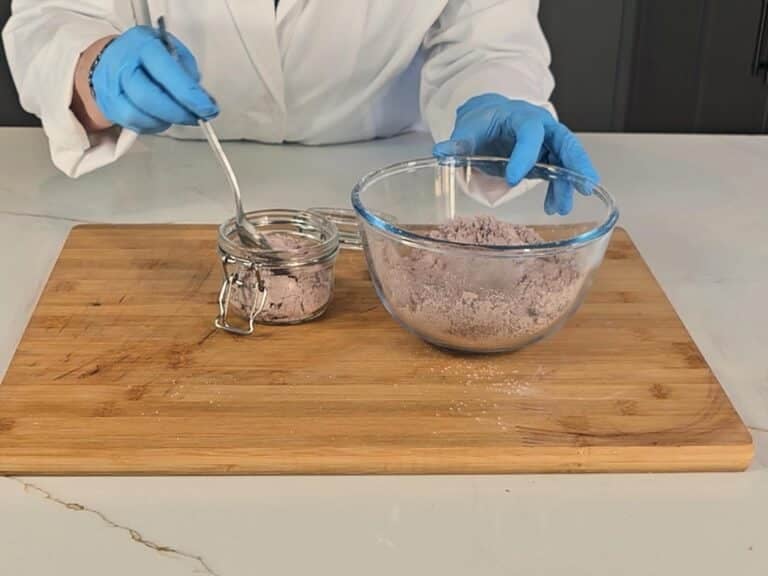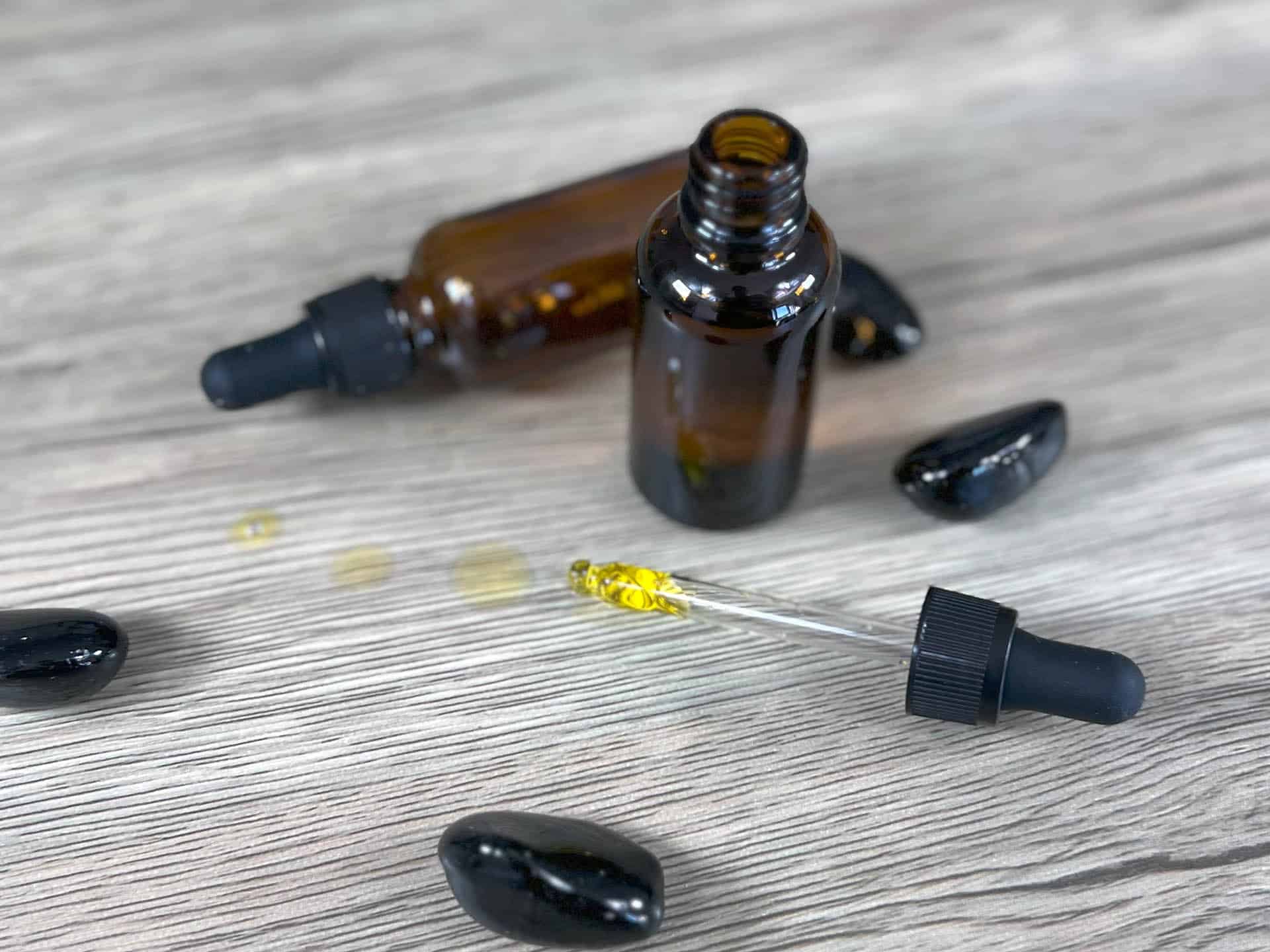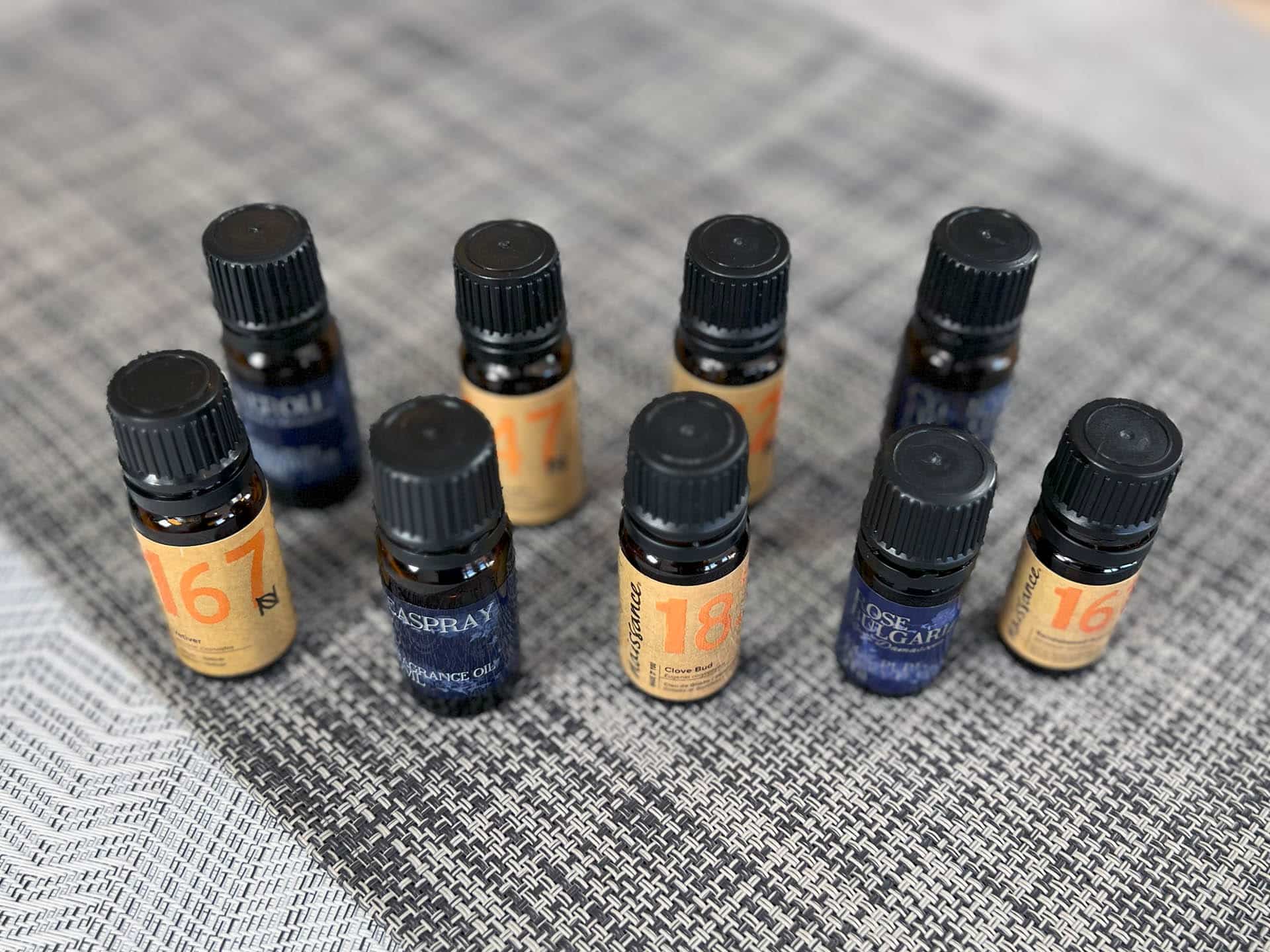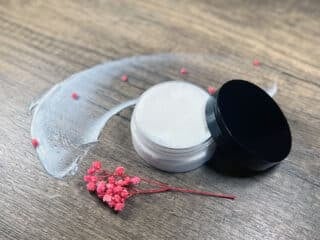I’ve been working hard on perfecting a dry shampoo for dark hair. Mainly because I’ve encountered a little problem I hadn’t anticipated. I have blonde hair, so when I add my DIY dry shampoo with cornstarch, it disappears immediately.
But I wanted to see if this would be the case for everyone. So, I gave it to a friend with black hair just to try it out. While it totally worked, she did tell me it took more effort to brush it through to avoid visible white residue from the powder in her hair.
As much as she could brush it through, It was clear to me my formulation wasn’t ideal for her, and might not be best for people with colored hair. So, how could I change my formula so that it’s easier to apply on black or colored hair types? That’s when I looked at my pigments to see what would work best.

Watch How To Make Dry Shampoo For Dark Hair
Best Pigments For Dark Hair
After many hours of experimenting, I’ve found your best pigment options. So, let’s dive into it.
Oxides
Oxide pigments generally are very strong and provide rich tones for our cosmetics. However, we only use a smidge here. Just enough to provide our powdered ingredients with a bit of camouflage.
They’re not expensive, but unless you’re really into making cosmetics already, you may not have this on hand. But I’d definitely recommend this one over all other choices. It’s reliable and fragrance-free, making it more consistent and versatile.
The only stipulation I have here is that it should be used sparingly and must be sifted with a sieve before adding to the bowl.
Recommended for medium to deep brown hair.
Cinnamon Powder
A great alternative to oxides is cinnamon powder! It also has a pleasant aroma that can be easily paired with your choice of aromatic oils for an interesting blend.
However, this is also its biggest drawback! Anyone who doesn’t enjoy the smell of cinnamon will want to skip this.
Recommended for dark blonde or light brown hair.
Clays
Clays are another good option as a pigment for dry shampoo. But I would only use red clay, as you’ll see no benefits from the others as pigment.
Clay, in general, is a good choice for a dry shampoo, as it’s fabulously absorbent in its own right. But regular white clay (kaolin or bentonite) won’t make much difference in your recipe. Red clay is the only one that will mimic natural hair tones.
Recommended for light to medium brown hair.
Activated Charcoal
Great for anyone with brown to black hair color. Activated charcoal can absorb and bind impurities, leading to a cleaner, healthier scalp. But, obviously, avoid this if you have lighter-colored hair, as it will change color!
Be careful when working with this one, as activated charcoal will stain fabrics easily. It will also stain your skin too, so be sure to handle it with gloves to avoid scrubbing your fingers later.
Recommended for dark brown or black hair.
Honorable Mentions
Pure Cocoa Powder
It might sound odd, but cocoa powder can work wonders as it also helps to regulate sebum production and control dandruff!
However, there’s a big but. You have to use pure, 100% cocoa. You don’t want any sugar in your hair. Just imagine how sticky your hair might feel after a hot summer’s day… Avoid instant drinking chocolate; only use the good stuff.
My only real gripe is that it’s not actually a very strong pigment. While the finished product is much more natural looking in the hair, you have to use A LOT… Especially compared with your other options.
Finely Ground Coffee
Finely ground coffee is another good beverage-related option. Coffee is also great for hair. Some studies even claim that coffee can stimulate hair growth at the root, leading to stronger, fuller hair.
However, go easy with this one. As much as we’re using finely ground, your dry shampoo can quickly become too gritty. Furthermore, the actual coffee grind doesn’t dissolve in water, as it could be a little trickier to wash out if you dump too much into your mixing bowl.
How Much Do I Use Of My Chosen Pigment?
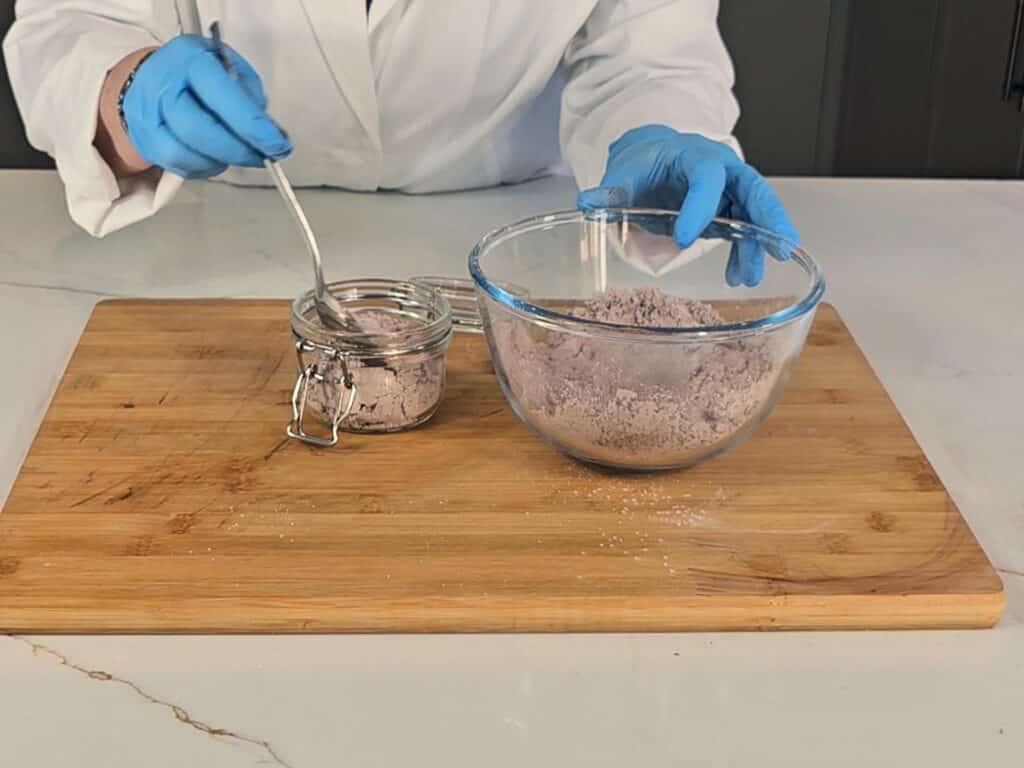
This is tough because it depends entirely on the color of your hair. However, there are some good places to start. But you may find that a little more or a little less will match your hair better.
Let’s break it down:
- Oxide: Start with 0.5g in a 100g batch size. Oxide is very strong, so it’s unlikely you’ll need much more.
- Cinnamon Powder: You might need to eyeball it, but you can add as much as you like.
- Clays: Because red clay is a fantastic absorbing agent, you can replace as much of your powdered ingredients for this ingredient as you like. But remember that dry shampoo will darken once applied to the hair.
- Activated Charcoal: 0.5 g in a 100g batch size, but be careful not to add too much as your dry shampoo may stain skin or clothing. Recommended only on dry shampoo for black hair or deep brown.
- Pure Cocoa Powder: Try replacing half your powdered ingredients with cocoa powder and see how it looks. Add more if necessary.
- Finely Ground Coffee: You might need to eyeball it, but try to avoid adding too much, as it can become a little gritty on the scalp. Might need to experiment to find a balance between tolerance and effectiveness as a pigment.
Be mindful when adding more pigment. Remember that our dry shampoo is a powder, and when powders get wet, they get darker in color. When our dry shampoo is applied to the hair, it’ll suction up all that excess oil. It becomes saturated, moist, and also darker in color.
Essentially, If we add too much pigment, it’s possible for our hair to change color when using the product. As much as that sounds cool, it won’t be on a busy Thursday morning before work.
Which recipe? You Decide!
You’ll notice I’ve provided multiple options for your recipe. That’s because you can use any of the dry shampoo recipes here on my blog. The only variable we’re concerned about here is the choice of pigment. But here are your options:
I followed my cornstarch formulation in the video and recipe below. It’s one of my favorites, but you can use whichever one takes your fancy.
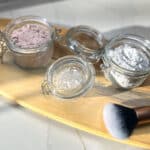
Dry Shampoo Recipe For Dark Hair
As an Amazon Associate, I earn from qualifying purchases. If you buy via the links here I may earn a small affiliate commission at no cost to you, please read my affiliate disclosure.
Ingredients
- 59 g Corn Starch
- 40 g Baking Soda
- 0.5 g Brown Oxide
- 0.5 g Orange Essential Oil (or your choice)
- 1 Mason Clip Jar (or Powder Spray Bottle)
Video
Instructions
- In a bowl, sift the cornstarch and baking soda and mix well.59 g Corn Starch, 40 g Baking Soda
- Mix all the ingredients thoroughly to ensure you have an even distribution of the components.
- Sprinkle in the essential oil and oxide, then mix again.0.5 g Orange Essential Oil, 0.5 g Brown Oxide
- Store the shampoo in a mason jar or powder spray bottle. Or a container with a lid, such as a clean and empty spice jar.1 Mason Clip Jar
How To Use Your Dry Shampoo
Using your dry shampoo for dark hair couldn’t be easier. Simply follow these simple instructions to get the most out of your dry shampoo:
- Begin by parting your hair. This will expose the roots and ensure the dry shampoo gets everywhere it needs to go.
- Apply the shampoo. You can do this easily if you store the product in a powder spray bottle, but it can also be applied with a hair or makeup brush.
- Massage the product into the scalp, ensuring the product is well distributed.
- Allow the product to sit for a few minutes.
- Brush or comb the hair through to remove any excess product.
If you follow these simple steps, the hair will not only look cleaner and fresher but smell and feel it, too!
Final Thoughts
Hope this post has helped some of you find ways to pigment your dry shampoo recipes! Let me know if you’ve found any other pigments to work in this context. Personally, I just loved working with the oxide. It was straightforward and easy to use.
Let me know if you have any questions or problems replicating homemade shampoos. I’ll do my best to help solve it, but I think you’ll probably be just fine with this dry shampoo, it has surprized me in just how easy they are to make!

